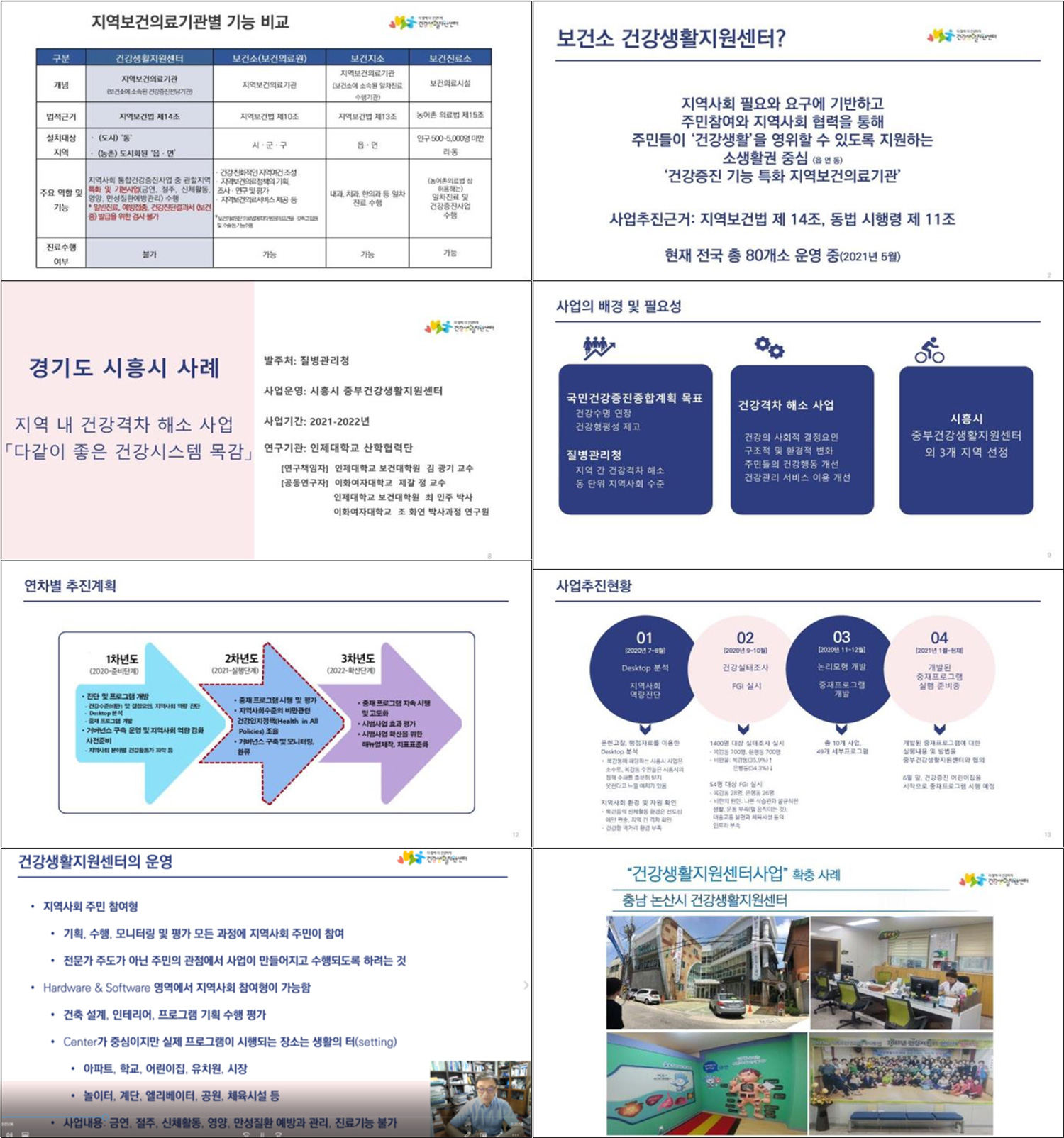한국연구재단 인문사회연구소지원사업 선정기념 세미나
한국연구재단 인문사회연구소지원사업 선정기념 세미나
Society–based Community Care Design
- 주관 : 인제대학교 디자인연구소
일시 : 2021.06.09.(수) 14:00-16:40
장소 : ZOOM 온라인 / 신어관 418호
참석인원 : 31명
돌봄경제와 커뮤니티 케어
발표자 및소속 : 은기수 (서울대학교 국제대학원장, 국제이주와 포용사회센터장)
돌봄경제는 한국에서 아직 생소한 개념이다. 돌봄, 돌봄노동은 익숙하지만, 돌봄에 경제가 붙은 돌봄경제는 매우 낯설고, 개념으로 존재하는지도 잘 모르는 새로운 개념이다.
일상생활에서 돌봄은 주로 자녀돌봄, 노인돌봄, 장애인돌봄 등으로 존재한다. 그러나 건강한 사람도 아프면 누군가에게 돌봄을 받아야 하고, 심지어는 돌봄을 제공하는 사람들도 아프면 돌봄을 받아야 하는 존재가 된다. 또한 임금을 받으면서 돌봄을 제공하는 돌봄노동자도 다른 한 편에서는 돌봄을 받아야 하는 존재이다.
한 축에 자녀돌봄, 노인돌봄, 장애인돌봄이 있고 이들은 돌봄을 받아야 하는 존재로 상정한다면, 경제학적으로는 이들은 돌봄의 수요(demand)를 유발하고 있고, 돌봄이 제공되면 돌봄을 소비(consumption)하게 된다고 볼 수 있다. 다른 한 축에는 무급돌봄제공자(주로 가족, 특히 여성) 및 유급돌봄노동자가 존재한다. 이들은 돌봄을 제공하는 사람들이고, 경제학적으로 이들의 돌봄제공은 공급(supply)이라고 표현될 수 있고, 돌봄을 상품으로 이해한다면 돌봄이라는 상품을 생산(production)하고 있다고 이해할 수 있다.
즉, 자녀돌봄, 노인돌봄, 장애인돌봄 등 돌봄의 수요와 유급 및 무급돌봄제공자에 의한 돌봄의 공급을 통해 돌봄이 이루어지는 것으로 파악하는데서 돌봄경제는 시작한다. 돌봄을 둘러싸고 수요와 공급, 생산과 소비가 이루어지는 영역이 돌봄경제이고, 돌봄을 돌봄경제로 파악하면서 돌봄에 관련된 수많은 문제에 대한 인식과 문제해결 방안에 대한 사고가 명료해진다.

보건소 건강생활지원센터의 활동: 시흥시 중부건강생활지원센터의 지역사회 시범사업 사례
김광기 (인제대학교 보건대학원장)
보건소 건강생활지원센터는 지역사회 필요와 요구에 기반하고 주민참여와 지역사회 협력을 통해 주민들이 건강한 생활을 영위할 수 있도록 지원하는 소생활권 중심의 ‘건강증진 기능 특화 지역보건의료기관’이다.
기획, 수행 모니터링 및 평가의 모든 과정에 지역사회의 주민이 참여하고, 전문가 주도가 아닌 주민의 관점에서 사업이 만들어지고 수행되도록 한다. 주 사업 내용은 금연, 절주, 신체활동, 영양, 만성질환 예방과 관리이다.

The relationship between wellbeing and urban neighbourhoods: Implications for community care
Christopher Boyko (Lancaster University, UK)
Where people live in cities, including those in community care, will have an impact on their wellbeing. Research shows that three issues have a key role to play: urban density, deprivation and walkability. Using this knowledge to develop a hypothesis, members of the UK EPSRC Liveable Cities project suggested that the wellbeing of residents who live in high-density and high-deprivation neighbourhoods is lower compared with residents living in other neighbourhoods. In addition, the authors hypothesised that high-density and high-deprivation neighbourhoods would be perceived as less walkable compared with other neighbourhoods.
To test these two hypotheses, the authors created a wellbeing questionnaire, containing 23 quantitative questions from a list of almost 3,000 international wellbeing indicators. The questionnaires were distributed to 233 adults living in 12 neighbourhoods in Birmingham, Lancaster and Southampton (UK). The neighbourhoods were divided into four types: (1) high-density and high-deprivation; (2) high-density and low-deprivation; (3) low-density and high-deprivation; and (4) low-density and low-deprivation. In addition, the authors used an app-based version of the Irvine-Minnesota Inventory to test the walkability of the 12 neighbourhoods.
Results indicated that residents of high-density, high-deprivation neighbourhoods had better levels of wellbeing compared with residents in low-density, high-deprivation areas. The former neighbourhoods also scored higher in terms of walkability. Furthermore, residents of low-density, low-deprivation neighbourhoods had the best wellbeing among the four different neighbourhood types whereas high-density, low-deprivation areas had the best walkability.
Although the hypotheses were proven incorrect (i.e., residents of high-density, high-deprivation neighbourhoods are not the worst off, nor are the neighbourhoods in terms of walkability), this study highlights that other issues need attention from urban and public health decision-makers. In particular, low-density, high-deprivation neighbourhoods require more scrutiny regarding how to improve the design of spaces and the health of their residents. Application of these results to the design of society-based community care are discussed.


